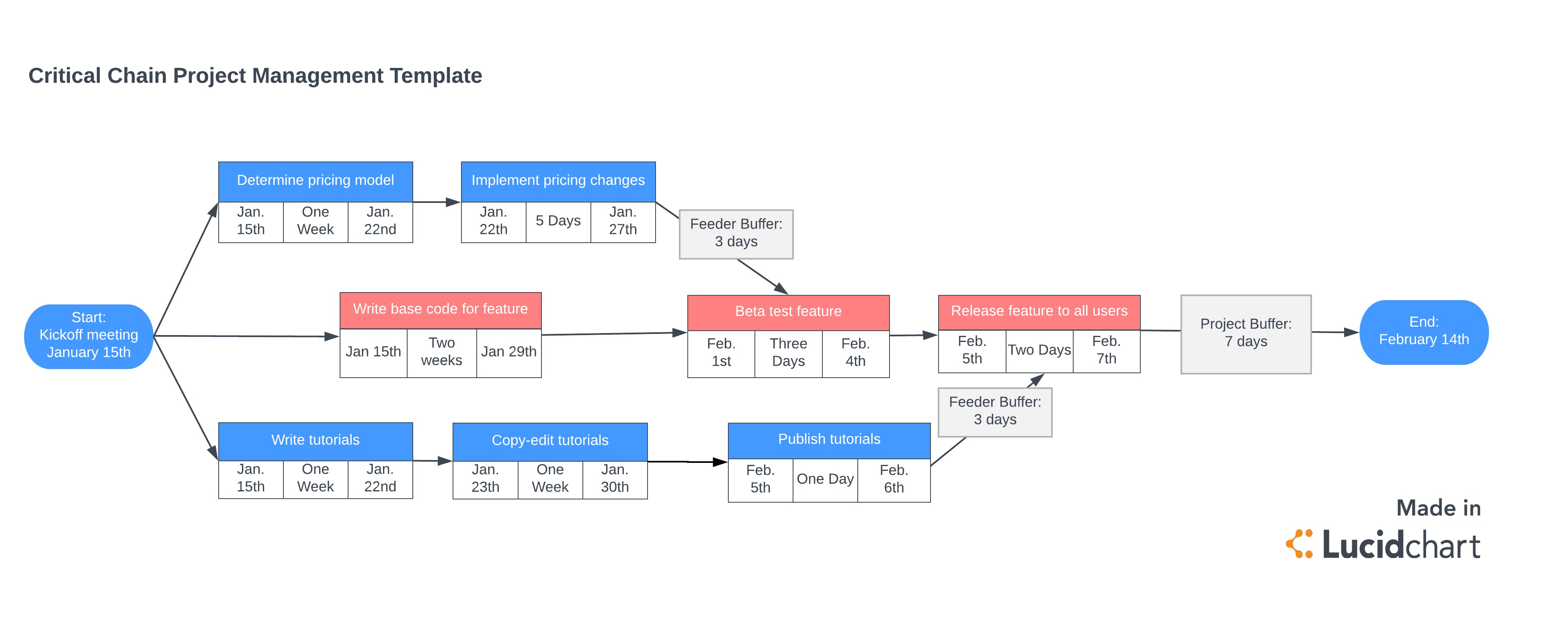What is Critical Chain Project Management (CCPM)?
Critical Chain Project Management is a network analysis schedule based on the Theory of Constraints which is focusing on finding and addressing inefficiencies to enhance the whole workflow. The CCPM accounts for task dependencies, a scarce supply of resources ( people, tools, physical space), and buffers required to effectively finish the project.
CCPM helps the project manager to prepare and control the project schedule by relying on the tools included in the Critical Path.

When to Use It?
The Critical Chain Project Management may be applicable both to large and small companies and to projects affecting sectors such as construction, software development, and technological research and development.
Critical Chain vs. Critical Path
what’s the difference between the critical chain and critical path methodology? When it comes to critical path methodology, you would:
- Work on selecting a series of tasks that will take the most time to accomplish, and arrange other tasks around it.
- Take time to find the best solution for the task organization and workflow of the project.
- Not to provide explicit buffers for the project
- Track project health depending on whether or not the deadlines for the specific activities have been reached.
And when it comes to critical chain method, you most likely would:
- Taking resource limitations/dependencies into account when designing projects
- Design a workflow that is near-optimal (or “good enough”)
- Add clear time buffers to the project plan (project buffer, feed buffers, and resource buffers)
- Track project health depending on how easily you consume your buffers
Of the two, critical path is the less flexible alternative, thus, best used for specifically defined ventures with few stakeholders.
Critical Chain is a more compact modification of the critical path approach that helps avoid inefficiencies such as switching tasks.
CCPM Types of Buffers
While the Critical Path Approach uses Float, the CCPM uses buffers as strategic points to remove project uncertainty.

Project Buffer – It protects the project from skipping the projected deadline of delivery and holds the date of completion intact. It is placed between the last assignment and the finish date at the end of the project network diagram.
Feeding Buffer – Placed between the last job on the non-critical chain and the critical chain. Such buffers are usually applied to the non-critical chain so that any lag in the non-critical chain does not affect the critical chain.
Resource Buffer – A virtual task that is added only before the critical chain tasks that involve critical resources (people, equipment). This serves as a trigger point for the resource, signaling that the critical path is about to start.
Capacity Buffer – It points out the on-call services expected in the event of unexpected money troubles emerging.
The specific steps in CCPM
The CCPM process contains a total of 7 steps:
1. Identify the critical chain
- Define the most significant tasks and those taking the longest time to finish. These tasks will become a critical path. You may build a work breakdown structure to help you find your critical path.
2. Determine resource constraints
- Critical Chain Project Management depends on resources — so consider any limitations you can face when assigning workers to assignments.
3. Limit your team’s focus
- In critical chain approach, it is crucial to keep the team focused on individual activities, as practice can lead to more efficient, harmonious, constructive, and creative behaviors.
4. Eliminate multitasking
- When workers switch between various tasks, productivity decreases, and the length of tasks increases. And, finally, staff morale is declining as the team members struggle to keep the project going on.
5. Create 50/50 time estimates
- Decrease all time estimates by 50% to avoid lost time and drive the team to a more effective schedule. (You should have buffers in place if the decreased time estimation is not rational).
6. Implement buffers for uncertainties or unexpected changes
- After you reduce the expected time required by 50%, the 50% will be used as a buffer. It serves as a shock absorber for the project if the task is longer than planned to be done.
7. Create a detailed project model
- Manage the project by tracking the supply of your services and managing the buffer consumption. If less than a third of the tampons are used, all is good. Where more than one third is used, evaluate the risks, and take appropriate measures. Beyond two thirds, a crisis unit must be set up.
Pros and Cons of The Approach
Advantages of using the CCPM method:
- It helps people to concentrate more on their work while increasing team morale and performance.
- It assists your team resolve the Student Syndrome phenomena (when people work more as the deadline approaches)
- Prevents the mismanagement of floats
- It deems the minimum time required to finish the project
- Accelerates execution of the project
- Allow a substantial reduction in capital needs
Disadvantages of using the CCPM method:
- It needs the dedication of the project team, the project manager, and the shareholders.
- There could be a lot of losses if the team doesn’t grasp the strategy to see the endpoint.
- The approach is not endorsed by some big planning packages.
- A new methodology thus it’s difficult to determine any long-term gains.

Leave A Comment?